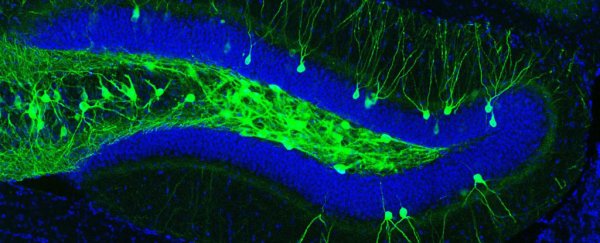Scientists have used light to stimulate brain cells in mice with Alzheimer's-like symptoms, and in doing so, have managed to recover memories that were otherwise lost to the disease.
Using a technique called optogenetics, in which living cells are manipulated via precise bursts of light, the researchers restored memories of learned behaviour in animals that had been genetically engineered to develop the kind of memory loss seen in early Alzheimer's. The findings suggest that the early onset of the disease might impact the retrieval of memories more than their encoding and subsequent storage.
In the study, mice were conditioned to associate fear with a particular cage in which they'd receive an unpleasant shock. Memory of the experience would lead healthy mice to freeze up once placed in the enclosure, but mice with Alzheimer's symptoms tended to freeze less frequently, showing evidence of progressive memory loss.
To restore the memories, scientists at Japan's RIKEN-MIT Centre for Neural Circuit Genetics used viruses to alter a region of the animals' hippocampus , or memory centre. This area, called the dentate gyrus, is where memory traces (aka engrams) are located. This allowed the team to identify and manipulate the particular neurons that constituted the memory traces associated with the cage conditioning.
When light bursts were administered to the animals' brains, the engram cells were reactivated, and the memory of the conditioning returned – albeit temporarily, lasting for only a day. However, repeated stimulation with the light bursts resulted in the memory returning for longer, up to six days.
"We have shown for the first time that increasing synaptic connectivity within engram cell circuits can be used to treat memory loss in mouse models of early Alzheimer's disease," said one of the researchers, Dheeraj Roy.
But why does this happen? According to the team, tiny spines observable in the dentate gyrus end up reducing as mice age and as Alzheimer's progresses, with less spines equalling less memory. However, these spines can regrow, increasing synaptic connectivity, and one of the ways this can be induced is via artificial stimulation by high-frequency light bursts.
Repeated stimulation with light saw the number of these spines in the Alzheimer's mice become indistinguishable from the healthy control group. Light stimulation on the healthy animals did not strengthen their already easy-to-retrieve memories, suggesting that the technique would only work on mice affected by memory impairment.
It's obviously very early days with this research, and results in mice by no means indicate results in humans, but it shows a promising new avenue for looking at how Alzheimer's could be affecting people, and might lead us to new ways to treat the disease and boost memory retrieval.
"The successful retrieval of memories in AD mice by increasing the number of spines for normal memory processing only in the memory cells, rather than in a broad population of cells, highlights the importance of highly-targeted manipulation of neurons and their circuits for future therapies," said one of the team, Susumu Tonegawa. "This level of specificity has not yet been accomplished in current deep brain stimulation therapies."
The findings are published in Nature.
